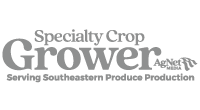By Choaa A. El Mohtar Projected citrus production in Florida for the 2022–23 season is less than 20 million boxes. This is more than a 90% decrease compared to the 2003–04 season, which was around 292 million boxes. The main reason for the decrease is huanglongbing (HLB) disease. The University of Florida Institute of Food and Agricultural Sciences (UF/IFAS) citrus …
CRAFT Update Provided at Citrus Industry Conference
During the Florida Citrus Industry Annual Conference earlier this month, Tamara Wood, executive director of the Citrus Research and Field Trial (CRAFT) Foundation, gave an update on a new phase of the CRAFT program. Started in 2019, CRAFT was initially focused on new plantings. The program helps growers cover the cost of new plantings if they agree to an experimental …
All In For Citrus Podcast, June 2023
Speaking at the Florida Citrus Industry Annual Conference in June, Scott Angle, leader of the University of Florida Institute of Food and Agricultural Sciences (UF/IFAS), reaffirmed the urgency the institution has placed on finding viable solutions to HLB. This includes presenting the citrus industry with a road-map document to lay out UF/IFAS HLB research priorities and objectives. One of the approaches …
Propagation Program Update on Donaldson and Other Trees
The Florida Citrus Commission (FCC) on June 14 received an update about a program for expedited propagation, in which 23 nurseries are participating. The goal of the expedited tree propagation program is to have several million HLB-tolerant or HLB-resistant trees planted in the next several years. Rosa Walsh, Florida Department of Citrus (FDOC) director of scientific research, provided the update. …
Angle Calls for Faster Research Progress on HLB
Scott Angle, University of Florida Institute of Food and Agricultural Sciences (UF/IFAS) senior vice president for agriculture and natural resources, began the educational session during the Florida Citrus Industry Annual Conference with a message of urgency. He recognized the critical threat posed by HLB and said science could catch up to the problem. “Plant sciences are advancing globally at almost …
Grower Observations on OTC Trunk Injection
Highlands County Citrus Growers Association (HCCGA) President Aaron Nelson recently shared observations about trunk injection of oxytetracycline (OTC) for trees with HLB. The first formulations for citrus trunk injection became available in January. His observations follow: Over the course of the last six months there have been countless hours spent injecting millions of trees all over the state. What follows …
Build Resilience in HLB-Affected Hamlin Trees
By Taylor Livingston and Tripti Vashisth Fighting HLB alongside weather disasters like freezes and hurricanes is leaving growers with little options for sustaining yields. The Hamlin sweet orange variety is known for higher susceptibility to HLB symptoms which cause rapid tree decline, including increased pre-harvest fruit drop and canopy loss. Production strategies that target fruit drop and canopy health improvement …
Drone Sprays for Psyllids Effective in Brazil
Using drones to apply chemical control for HLB-spreading psyllids in Brazil proved effective against adult insects, a Fundecitrus researcher reported. The researcher, Marcelo Miranda, said psyllid mortality was above 80% as a result of drone applications. Miranda’s work was pioneering in 2021. There was no record of the use of drones for the chemical control of the psyllid in western …
Psyllids Resistant to Insecticides in Brazil
Psyllids collected in orchards in four microregions of Brazil’s citrus belt showed reduced susceptibility to insecticides from the pyrethroid and neonicotinoid chemical groups. That information was reported earlier this year by agronomist and researcher Fernando Amaral of the Arthropod Resistance Laboratory at the Luiz de Queiroz College of Agriculture/University of São Paulo (ESALQ/USP). This was the first confirmation of psyllid …
Sustaining Citrus With Soil Improvement
By Frank Giles HLB has taken a toll on growers both large and small over the years. That’s been the case with third-generation grower Chuck Bellamy, who grows citrus near Inverness, Florida. His grandparents planted the first trees on the property in 1930. A few of those trees are still alive in the grove nearly 100 years later. Bellamy says …
Antibiotics, HLB and Psyllids
Entomologist Kirsten Pelz-Stelinski recently shared findings from trials on the use of foliar-applied and trunk-injected antibiotics for controlling HLB and the Asian citrus psyllids (ACP) that spread the disease. Pelz-Stelinski is associate center director at the University of Florida Institute of Food and Agricultural Sciences (UF/IFAS) Citrus Research and Education Center (CREC) in Lake Alfred. In a May 17 presentation …
HLB in Florida Is a Warning to California
The damage that HLB has inflicted on Florida citrus groves and production over the past 18 years should serve as a warning for California producers, California’s Citrus Pest & Disease Prevention Program (CPDPP) stated recently. CPDPP noted that with HLB detected in thousands of California residential trees, it’s important for commercial growers to take steps to prevent the disease. According …
Repurposing Tools to Tackle HLB
By J. Scott Angle, jangle@ufl.edu, @IFAS_VP The hurricane-battered harvest numbers don’t show it, but we’re in a much better place in developing scientific solutions for managing HLB than we were a year ago. That’s because our scientists have discovered that tools invented to solve other problems can help address your one big problem. GIBBERELLIC ACIDFor example, gibberellic acid (GA) has …
Awareness Campaign Battles HLB in Brazil
Brazil’s Fundecitrus in 2022 and 2023 conducted an awareness campaign to replace citrus and myrtle plants to combat HLB in the municipality of Itobi, São Paulo. The citrus and myrtle plants were replaced with other fruit and ornamental species that do not host the Asian citrus psyllid that transmits HLB, also known as greening disease. These citrus and myrtle plants …
Native Lime Might Keep HLB Out of Australia
A comprehensive map of the genome of an Australian native lime species that is resistant to HLB could be the key to preventing the disease from entering Australia. Researchers from The University of Queensland (UQ) in Australia have sequenced the genome of the Australian round lime, also known as the Gympie lime. They are now looking at five other native …
Determine Tree Health With Canopy Assist
By Amit Levy and Tripti Vashisth Many Florida citrus growers are currently injecting oxytetracycline, spraying gibberellic acid (GA) or treating trees with enhanced nutrition. A new program offered by the University of Florida Institute of Food and Agricultural Sciences (UFIFAS) Citrus Research and Education Center (CREC) can help growers determine if these treatments are improving tree health and leading to …
Growers Share First Impressions of Trunk Injection
The Peace River Valley Citrus Growers Association (PRVCGA) hosted growers and industry members on National Orange Juice Day to discuss early experiences with trunk injection of oxytetracycline hydrochloride (OTC-HCl). Two new OTC-HCl products, ReMedium TI and Rectify, were registered this season for use as an HLB treatment in Florida citrus. While some growers are taking a wait-and-see approach to trunk …
Exploring Additional Antimicrobials for Citrus Injection
The Citrus Research and Development Foundation (CRDF) board of directors invited six full proposals on combining other antimicrobials with oxytetracycline hydrochloride (OTC-HCl) during its April meeting. “If growers are going to pay the labor costs for workers to crawl underneath a citrus tree to treat it with OTC-HCl, maybe there are other things that could be mixed with the injection,” …
New Twist Added to Psyllid Control
Lukasz Stelinski for years has promoted saving money on HLB control by spraying for Asian citrus psyllids (ACP) only when their populations reach a certain threshold. The University of Florida Institute of Food and Agricultural Sciences professor still promotes that concept, but with a slightly new twist. TRUNK INJECTION SHOWING PROMISEIn a virtual seminar on April 25, Stelinski advised growers …
Cytokinin Studied for Citrus Health Benefits
Tripti Vashisth, University of Florida Institute of Food and Agricultural Sciences associate professor, has been leading the research on how plant growth regulators (PGRs) can improve the health of HLB-infected trees. She’s conducted extensive research on the use of gibberellic acid. But she has recently begun to study another hormone, cytokinin. She gave an update on this work during the …




























